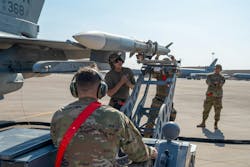RTX Raytheon to build as many as 1,000 radar-guided air-to-air missiles with upgraded signal processing
Questions and answers:
- What is the purpose of the recent $3.5 billion contract awarded to RTX Raytheon? The contract is for the production of as many as 1,000 AIM-120 AMRAAM medium-range air-to-air missiles, telemetry systems, spare parts, and engineering support.
- What is the AMRAAM F3R upgrade, and why is it important? The F3R (form, fit, function refresh) upgrade enhances the missile’s signal processing, guidance systems, and electronic warfare capabilities, helping to address parts obsolescence and improve performance in contested environments.
- Which countries are included in the foreign military sales of the AMRAAM missile? Countries include Denmark, Belgium, Japan, The Netherlands, Canada, Finland, Germany, Hungary, Spain, Poland, Sweden, Taiwan, Lithuania, the UK, Australia, Switzerland, Ukraine, Israel, and Kuwait.
EGLIN AIR FORCE BASE, Fla. – U.S. Air Force aerial warfare experts are asking RTX Corp. to build as many as a thousand medium-range air-to-air missiles under terms of a $3.5 billion contract announced in late July.
Officials of the U.S. Air Force Life Cycle Management Center at Eglin Air Force Base, Fla., are asking the RTX Raytheon segment in Tucson, Ariz., for production lots 39 and 40 of the AIM-120 Advanced Medium Range Air to Air Missile (AMRAAM).
AMRAAM is an active radar-intercept missile with inherent electronic protection capabilities for air-to-air applications against massed penetration aircraft. AMRAAM has been in service since 1991, and was designed to replace the AIM-7 Sparrow radar-guided air-to-air missile.
This contract provides for the production of AMRAAM missiles, AMRAAM telemetry systems, initial and field spare parts, and other production engineering support.
International military sales
This contract involves foreign military sales to Denmark, Belgium, Japan, The Netherlands, Canada, Finland, Germany, Hungary, Spain, Poland, Sweden, Taiwan, Lithuania, the United Kingdom, Australia, Switzerland, Ukraine, Israel, and Kuwait. Each AMRAAM lot roughly consists of 400 to 500 missiles.
The U.S. Air Force and Navy AMRAAM is one of the nation's most sophisticated radar-guided air-to-air missiles, and one of the world's most advanced all-weather, all-environment, medium-range air-to-air missiles for engaging enemy aircraft and missiles from beyond visual ranges.
Since AMRAAM lot 32, Raytheon AMRAAM production has involved missiles that integrate the form, fit, function refresh (F3R) of the AMRAAM guidance section, which seeks to mitigate the effects of parts obsolescence and diminishing manufacturing sources in the missile's guidance section.
Mitigating the effects of obsolescence and diminishing manufacturing sources can involve the substantial redesign of subsystems by replacing electronic chips and other components that the original manufacturers no longer can produce.
Tell me more about the best radar-guided air-to-air missiles in the world ...
- The best radar-guided air-to-air missiles in the world, known for their advanced technology, range, and reliability, are considered to be the AIM-120 AMRAAM; MBDA Meteor; Israeli I-Derby ER; and the Russian R-77. Among these, the Meteor and AIM-120 AMRAAM (especially AIM-120D) are widely considered to be the top radar-guided air-to-air missiles in the world because of their range, precision, maneuverability, and operational use by several international air forces. Other notable radar-guided missiles are the Chinese PL-15; and the Russian R-37 super-long-range hypersonic missile with active radar, for use primarily against high-value targets. Among these, the Meteor and AIM-120 AMRAAM (especially AIM-120D) are widely considered the top elite radar-guided air-to-air missiles worldwide due to their range, precision, maneuverability, and operational use by multiple leading air forces.
In January 2017 Raytheon officials announced a project to develop a new signal processor for the AMRAAM under the F3R project to help ensure AMRAAM production through the end of the 2020s.
The AMRAAM F3R upgrade is a significant advancement to the missile’s signal processing and overall capabilities. The project involves upgraded signal processing and hardware; improved guidance section; enhanced electronic warfare (EW) performance; agile software updates; simulation tools for development; and improved platform integration.
The F3R program replaces legacy electronics in the missile's guidance section with at least 15 upgraded circuit cards developed using model-based systems engineering. These upgrades provide a substantial increase in computational power for the missile’s radar signal processor.
Enhanced signal processing uses advanced guidance algorithms for improved target tracking, discrimination, and target engagement in complex electronic warfare environments.
AMRAAM upgrades
EW enhancements enable the AMRAAM to counter current and emerging electronic warfare threats by processing signals more rapidly in dense and contested electromagnetic environments.
AMRAAM F3R variants like the AIM-120D-3 can receive signal-processing algorithms that can be improved continuously without another major hardware overhaul. F3R also uses the M-Sim simulation tool that enables rapid prototyping, testing, and integration of advanced signal processing software onto the new hardware to speed development and fielding.
On this contract RTX Raytheon will do the work in Tucson, Ariz., and should be finished by late 2031. For more information contact RTX Raytheon online at www.rtx.com/raytheon/news/2022/07/13/amraam-evolution.
About the Author
John Keller
Editor-in-Chief
John Keller is the Editor-in-Chief, Military & Aerospace Electronics Magazine--provides extensive coverage and analysis of enabling electronics and optoelectronic technologies in military, space and commercial aviation applications. John has been a member of the Military & Aerospace Electronics staff since 1989 and chief editor since 1995.
